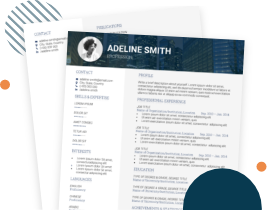
The Europass CV is great for applying for jobs within Europe — here’s everything you need to know!

When it comes to writing a CV, there are so many templates and formats to choose from that it can get confusing. Do you choose a chronological or a skills-based format? Do you keep the design simple or use a fancy template? The choice can be overwhelming.
To keep things simple, if you’re applying for a role within Europe, you can overcome the confusion by using the Europass CV. Rather than worrying about what type of CV to choose, working with a Europass CV template means your CV will be easy to put together and easily recognisable by EU employers and educational institutions alike.
In this article, you will learn what a Europass CV is, what to use it for and how to put one together with our top tips, as well as see an example in action.
TABLE OF CONTENTS
The Europass CV is one of the best-known résumé formats within Europe. Like a standard CV, its purpose is to present your work history, education, skills and other important information to potential employers.
It is part of the online Europass platform, an incentive set out by the EU to help create some uniformity and transparency of experience and qualifications so that they’re clearly understood by employers throughout Europe.
As well as offering an online CV editor, the Europass platform provides four other tools:
While the idea of having a uniform system for assessing candidates has been praised, others find the process very restrictive. There are different views on its effectiveness. Here are some advantages and disadvantages of the Europass CV.
Those who support the Europass CV believe it holds many advantages over a less structured CV approach, including:
While Europass has support and is widely accepted, it does have its disadvantages, such as:

Creating a Europass CV is a fairly simple process, and it can be broken down into four steps:
Setting up a Europass Profile is completely free. You don’t have to create an account but it’s a good idea that you do so that you can save your information and progress and return to the website later to make any changes. If you don’t create an account, it’s important to note that any information you enter on the platform will be deleted after 48 hours and so you’ll need to start all over again.
Once you create an account, head over to the Europass CV editor, where you’ll be invited to complete the different sections of your CV, specifically your personal details, a summary, your professional experience, education and training, and skills and competencies. You can also add additional sections language skills, publications, volunteer work, and hobbies and interests.
When you’ve added all your information to your CV, you can select an appropriate design for it from a selection of templates. In this step, you can also edit your CV’s colour palette, change font size and add page numbers. There’s also an option to remove the Europass logo from your CV here, which is automatically added to the first page.
All you have to do now is save your CV in your Europass Library or publish it on EURES (a cooperation network of employment services aimed to facilitate employment mobility among EU member states) — provided that you’ve created a Europass Profile. You can also download your CV as a PDF file. (Make sure to give it an appropriate name, like ‘John Smith CV’.)
Prefer to use a CV template? We offer a variety of professionally designed and ATS-optimised templates to help you stand out. Browse CV templates
As with writing any type of CV, there are certain things you can do to make yours stand out from other candidates and mistakes to avoid making. Here are some tips to keep in mind:
When describing your experience, make sure that you use short statements — this makes your CV more readable and easily understandable, and it shows that you respect the reader’s time. On that note, it’s a good idea to avoid clichés like ‘excellent problem-solver’ and to start statements with action words like ‘oversaw’ and ‘supervised’.
Rather than just including everything and anything in your CV, make sure the information you pick is relevant to the role you’re applying for. A good idea here is to look at the job description to identify key words and phrases and any relevant details, and incorporate these into your CV.
Make sure your CV highlights your results and achievements with facts and figures. Use percentages to show improvement and numbers to indicate things like how many people you manage, how much money you saved a company and how you scored in an appraisal.
It’s not all about skills that feel very specific to the job you’re applying for. Employers want to know about your transferable skills, too — so, make sure you highlight things like communication skills, leadership abilities and a desire to collaborate.
A common mistake people often make with a CV is getting tenses muddled. Your current role should be written in the present tense (although some achievements that have passed may be in the past tense). Previous roles should always be written in the past tense.
It may sound like an obvious thing to do, but make sure you give your CV a thorough proofread before submitting. A CV with lots of errors will give a bad impression, even if your experience is amazing. It shows a lack of attention to detail or, worse, a lack of effort. Grammar must be checked, as well as spelling and formatting.